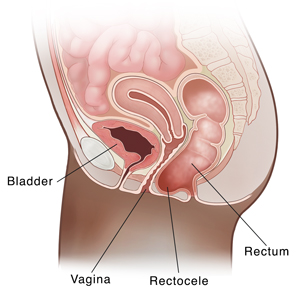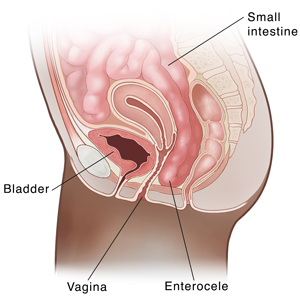The organs in the pelvis are supported by structures around them. Things like aging and childbirth can cause these structures to weaken. Loss of support lets pelvic organs fall out of their normal position. This is called prolapse. If the rectum falls out of place and bulges into the vagina, it's called rectocele. If the small intestine falls out of place and bulges into the vagina, it's called enterocele. Surgery can be done to fix these problems. This will help relieve your symptoms.
The surgical procedure
-
To correct a rectocele, the rectum is moved back to its normal position. The tissue between the vagina and rectum is stitched (sutured) to strengthen it. This stops the rectum from bulging into the vagina.
-
To correct an enterocele, the small intestine is moved away from the vagina. Excess tissue is then excised and stitched. This holds it in place.
-
Sometimes a synthetic material or biologic graft is used in the process of correcting the defect. The FDA has warned against using some mesh products. Ask what the risks are if your surgeon plans on using mesh.
Your incisions
During surgery, the surgeon reaches your pelvic organs through the vagina or the belly (abdomen). If going through the vagina, they may make cuts (incisions) in the wall of the vagina. If the surgery is through the abdomen, they may use several small incisions to do laparoscopic or robotic surgery. Or they may use one larger incision either up and down (vertical) or across (transverse).
Risks of surgery
-
Infection
-
Bleeding
-
Risks of anesthesia
-
Damage to nerves, muscles, or nearby pelvic structures
-
Blood clots
-
Prolapse of the pelvic organ or organs occurring again
-
Fistula, an abnormal connection from the bowel to the vagina
Featured in



